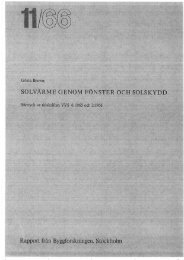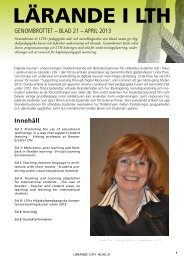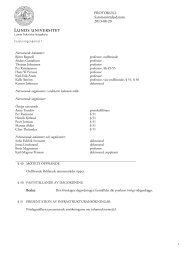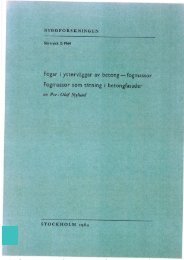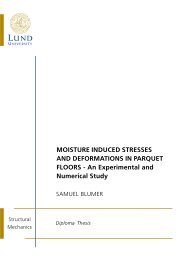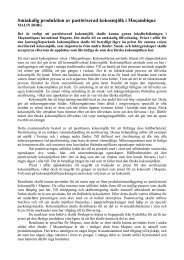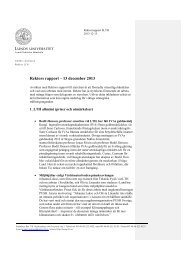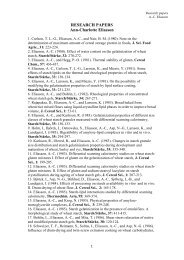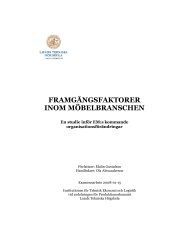User Experience Design at Sony Ericsson - Introducing the Virtual Pet
User Experience Design at Sony Ericsson - Introducing the Virtual Pet
User Experience Design at Sony Ericsson - Introducing the Virtual Pet
Create successful ePaper yourself
Turn your PDF publications into a flip-book with our unique Google optimized e-Paper software.
1. Introduction<br />
In traditional usability engineering, ease of use is seen as one of <strong>the</strong> main factors contributing to users’ experience<br />
of a product (Nielsen 1993). Usability researchers have long stressed th<strong>at</strong> designers should focus on ease of use<br />
r<strong>at</strong>her than aes<strong>the</strong>tic decor<strong>at</strong>ion when designing products (Norman 1988). Some advoc<strong>at</strong>es of usability have<br />
claimed th<strong>at</strong> this ease of use gives joy of use (Nielsen 2002), o<strong>the</strong>r researchers argue th<strong>at</strong> usability merely can be<br />
seen as a diss<strong>at</strong>isfier, only noticed when absent and not able to evoke pleasurable experiences alone (Jordan 2000).<br />
Nowadays, usability engineering is practiced by all major phone manufacturers, and <strong>the</strong> technical characteristics of<br />
mobile phones are becoming increasingly similar. Weight and b<strong>at</strong>tery life are two of <strong>the</strong> fe<strong>at</strong>ures th<strong>at</strong> are easy to<br />
compare and <strong>the</strong>refore used to be good arguments for choosing one phone over ano<strong>the</strong>r. Now things are<br />
changing as even low-end manufacturers are offering products th<strong>at</strong> are lightweight and have s<strong>at</strong>isfying b<strong>at</strong>tery life,<br />
all <strong>at</strong> a low price. This toughens <strong>the</strong> competition and forces companies to differenti<strong>at</strong>e to stay alive.<br />
One of <strong>the</strong> lucr<strong>at</strong>ive ways to differenti<strong>at</strong>e from <strong>the</strong> low-end manufacturers might be to put more effort into<br />
aes<strong>the</strong>tical design of products and less into functionality and ease of use (Dumaine 1991). Though <strong>the</strong>re is no<br />
implicit contradiction in designing products th<strong>at</strong> sell thanks to enchanting appearance and ease of use, <strong>the</strong> idea of<br />
competing with aes<strong>the</strong>tics often raises questions regarding ease of use. Usability scholars will inevitably ask if it is<br />
reasonable to sacrifice <strong>the</strong> usability of products for a glossier look (Norman 1988). The question is <strong>the</strong> ancient one<br />
of form vs. function - dressed up in a slightly upd<strong>at</strong>ed costume - and has only one answer within a company:<br />
Yes, if it increases customer s<strong>at</strong>isfaction.<br />
From this point of view, usability is not an end in itself as it is not wh<strong>at</strong> sells products. In <strong>the</strong> end, wh<strong>at</strong> makes a<br />
customer buy - for example - a mobile phone, is not just fe<strong>at</strong>ures and ease of use. Customers must be delighted to<br />
return; merely s<strong>at</strong>isfying <strong>the</strong>ir spoken needs is not enough (Schneider & Bowen, 1999). As noted earlier, it is<br />
questionable if it is possible to delight customers with ease of use only (Jordan 2000).<br />
Recent research suggests th<strong>at</strong> <strong>the</strong> visual appeal of a product can influence perceived usability (Tractinsky 2000).<br />
Fur<strong>the</strong>rmore, neuropsychological liter<strong>at</strong>ure and studies in <strong>the</strong> field of decision <strong>the</strong>ory suggest th<strong>at</strong> affective<br />
responses precede cognition (Thorn 2001). This view of users as r<strong>at</strong>ional and emotional have gained ground, as<br />
shown when even one of <strong>the</strong> most influential names in <strong>the</strong> world of human computer interaction – Donald<br />
Norman – comes out of <strong>the</strong> closet and encourages aes<strong>the</strong>tic design by saying th<strong>at</strong> “<strong>at</strong>tractive things work better”<br />
(Norman 2002).<br />
So how do we design <strong>at</strong>tractive things? The delighting fe<strong>at</strong>ures of a mobile phone need to be explored in order to<br />
design a pleasurable experience. Who do we turn to? The field of usability researchers have mostly focused on<br />
elimin<strong>at</strong>ing distractions and not so much on cre<strong>at</strong>ing pleasure (Jordan 2000). It could be suggested th<strong>at</strong> one<br />
should turn to professionals like game- and filmmakers, architects and car designers, who seem to know how to<br />
engage and capture people - something highly desirable when cre<strong>at</strong>ing consumer products. Unfortun<strong>at</strong>ely, <strong>the</strong>re is<br />
r<strong>at</strong>her limited formal research on why products in <strong>the</strong>se areas are successful; decisions seem to be made mostly on<br />
intangible gut feelings and tacit knowledge (Cain 1998).<br />
The challenge for today’s interaction designers is to demystify <strong>the</strong> “lone design genius” so th<strong>at</strong> good designs can<br />
be explained, reproduced and communic<strong>at</strong>ed to o<strong>the</strong>rs. For this to happen, new frameworks of user experience<br />
design will have to be introduced. These new frameworks have to be accompanied by evalu<strong>at</strong>ion methods th<strong>at</strong><br />
assess users’ experiences and s<strong>at</strong>isfaction r<strong>at</strong>her than <strong>the</strong>ir performance.<br />
1



